Did an Ultra-Low Emissions Policy on Coal-Fueled Thermal Power Reduce the Harmful Emissions? Evidence from Three Typical Air Pollutants Abatement in China
Abstract
:1. Introduction
1.1. Development History of Thermal Power
1.2. History of Thermal Power Emissions Reductions in China
1.3. Policy Release Background
1.4. Policy Implications for China
1.5. ULE Technical Route
2. Literature Review and Hypothesis
2.1. Background on ULE Policy in the Power Industry
2.2. Review on Policy Testing Methods
2.3. Research Hypothesis
3. Methods
3.1. Selection of the Treated and Control Groups
3.2. Model Specification
3.3. Data Sources and Variable Descriptive Statistics
4. Empirical Results
4.1. Effect Test of ULE
4.1.1. Emissions Reduction for SO2
4.1.2. Emission Reductions for NOx
4.1.3. Emissions Reduction for Smoke Dust
4.2. Robustness Test
4.2.1. Parallel Trend Test
4.2.2. Placebo Test
5. Conclusions and Suggestions
Author Contributions
Funding
Acknowledgments
Conflicts of Interest
Abbreviations
| ULE | Ultra-low Emission |
| DID | Difference-in-Difference |
| Btu | British Thermal Unit |
| SO2 | sulfur dioxide |
| NOx | nitrogen oxide |
| kWh | kilowatt hour |
| tce | Ton (Tonne) of Coal Equivalent |
| Obs | number of observations |
| Mean | mean value |
| St.d | standard deviation |
| Min | minimum value |
| Median | Median value |
| Max | maximum value |
| R2 within | goodness of fit within the group |
References
- Koplitz, S.N.; Jacob, D.J.; Sulprizio, M.P.; Myllyvirta, L.; Reid, C. Burden of Disease from Rising Coal-Fired Power Plant Emissions in Southeast Asia. Environ. Sci. Technol. 2017, 51, 1467–1476. [Google Scholar] [CrossRef] [PubMed] [Green Version]
- Gao, J.; Tian, H.; Cheng, K.; Lu, L.; Zheng, M.; Wang, S.; Hao, J.; Wang, K.; Hua, S.; Zhu, C.; et al. The variation of chemical characteristics of PM2.5 and PM10 and formation causes during two haze pollution events in urban Beijing, China. Atmos. Environ. 2015, 107, 1–8. [Google Scholar] [CrossRef]
- Mu, Q.; Zhang, S.Q. The Economic Cost Evaluation of Haze Events in China. China Environ. Sci. 2013, 33, 2087–2094. (In Chinese) [Google Scholar]
- Chen, Q.; Sun, F.; Xu, Y. Does winter heating cause smog? Evidence from a city panel in north China. Nankai Econ. Stud. 2017, 4, 25–40. (In Chinese) [Google Scholar] [CrossRef]
- Li, J.; Qi, Z.; Li, M.; Wu, D.; Zhou, C.; Lu, S.; Yan, J.; Li, X. Physical and Chemical Characteristics of Condensable Particulate Matter from an Ultralow-Emission Coal-Fired Power Plant. Energy Fuels 2017, 31, 1778–1785. [Google Scholar] [CrossRef]
- National Environmental Protection Agency. Emission Standards of Air Pollutants for Thermal Power Plants (GB 13223-1991); China Standards Press: Beijing, China, 1991; Volume GB 13223-1991. [Google Scholar]
- National Environmental Protection Agency. Emission Standards of Air Pollutants for Thermal Power Plants (GB 13223-1996); China Standards Press: Beijing, China, 1996; Volume GB 13223-1996. [Google Scholar]
- National Environmental Protection Agency. Emission Standard of Air Pollutants for Thermal Power Plants (GB13223-2003); China Standards Press: Beijing, China, 2003; Volume GB13223-2003. [Google Scholar]
- National Environmental Protection Agency. Emission Standard of Air Pollutants for Thermal Power Plants (GB 13223-2011); China Standards Press: Beijing, China, 2011; Volume GB 13223-2011. [Google Scholar]
- National Development and Reform Commission; Ministry of Ecology and Environment of P.R China; National Energy Administration. Full Implementation of the Ultra-Low Emission and Energy-Saving Transformation Work Plan for Coal-Fired Power Plants; General Office of the Ministry of Environmental Protection: Beijing, China, 2015; Volume 000014672/2015-01407. [Google Scholar]
- General Office of the State Council. Energy Development Strategy Action Plan (2014-2020); General Office of the State Council: Beijing, China, 2014. [Google Scholar]
- National Development and Reform Commission; Ministry of Ecology and Environment of P.R China; National Energy Administration. Coal-Fired Energy-Saving Emission Reduction Upgrade and Transformation Action Plan (2014-2020); National Energy Administration: Beijing, China, 2014. [Google Scholar]
- Chen, W.; Xu, R. Clean coal technology development in China. Energy Policy 2010, 38, 2123–2130. [Google Scholar] [CrossRef]
- Räsänen, T.A.; Koponen, J.; Lauri, H.; Kummu, M. Downstream Hydrological Impacts of Hydropower Development in the Upper Mekong Basin. Water Resour. Manag. 2012, 26, 3495–3513. [Google Scholar] [CrossRef]
- Tabar, M.R.R.; Anvari, M.; Lohmann, G.; Heinemann, D.; Wächter, M.; Milan, P.; Lorenz, E.; Peinke, J. Kolmogorov spectrum of renewable wind and solar power fluctuations. Eur. Phys. J. Spec. Top. 2014, 223, 2637–2644. [Google Scholar] [CrossRef]
- Ye, P.; Li, Y.; Zhang, H.; Shen, H. Bibliometric analysis on the research of offshore wind power based on web of science. Econ. Res.-Ekon. Istraživanja 2020, 33, 887–903. [Google Scholar] [CrossRef] [Green Version]
- Wu, Y. Public acceptance of constructing coastal/inland nuclear power plants in post-Fukushima China. Energy Policy 2017, 101, 484–491. [Google Scholar] [CrossRef]
- Balzani, V.; Armaroli, N. Energy for a Sustainable World: From the Oil Age to a Sun-Powered Future; John Wiley & Sons: Hoboken, NJ, USA, 2010. [Google Scholar]
- Arghode, V.K.; Gupta, A.K.; Bryden, K.M. High intensity colorless distributed combustion for ultra low emissions and enhanced performance. Appl. Energy 2012, 92, 822–830. [Google Scholar] [CrossRef]
- Na, C.; Yuan, J.; Xu, Y.; Hu, Z. Penetration of clean coal technology and its impact on China’s power industry. Energy Strategy Rev. 2015, 7, 1–8. [Google Scholar] [CrossRef]
- Wang, J.; Zhang, Y.; Liu, Z.; Gu, Y.; Norris, P.; Xu, H.; Pan, W.-P. Coeffect of Air Pollution Control Devices on Trace Element Emissions in an Ultralow Emission Coal-Fired Power Plant. Energy Fuels 2019, 33, 248–256. [Google Scholar] [CrossRef]
- Vukosavić, S.; Popov, N.; Despotović, Ž. Power electronics solution to dust emissions from thermal power plants. Serb. J. Electr. Eng. 2010, 7, 231–252. [Google Scholar] [CrossRef]
- Cao, R.; Tan, H.; Xiong, Y.; Mikulčić, H.; Vujanović, M.; Wang, X.; Duić, N. Improving the removal of particles and trace elements from coal-fired power plants by combining a wet phase transition agglomerator with wet electrostatic precipitator. J. Clean. Prod. 2017, 161, 1459–1465. [Google Scholar] [CrossRef]
- 24 Chen, Y.B.; Zhang, Y.; Ling, W. Practice on Ultra-low Emission and Energy Efficient Technologies in Coal-fired Power Plants. Front. Eng. Manag. 2016, 3, 377–383. [Google Scholar] [CrossRef] [Green Version]
- Han, W. Coal-fired Power Plants Ultra-low Emissions: Opportunities and Challenges. Environ. Prot. 2016, 44, 39–41. (In Chinese) [Google Scholar] [CrossRef]
- Zhao, X.; Zhu, F. Simulation Study of the Impacts of Ultra-low Emission Implemented in Thermal Power Plants on PM2.5 Mass Concentration in Ambient Air of Jiangsu Province. Electr. Power 2019, 12, 1–8. (In Chinese) [Google Scholar]
- Tang, L.; Qu, J.; Mi, Z.; Bo, X.; Chang, X.; Anadon, L.D.; Wang, S.; Xue, X.; Li, S.; Wang, X.; et al. Substantial emission reductions from Chinese power plants after the introduction of ultra-low emissions standards. Nat. Energy 2019. [Google Scholar] [CrossRef]
- Jin, Y.; Peng, W.; Urpelainen, J. An ultra-low emission coal power fleet for cleaner but not hotter air. Environ. Res. Lett. 2020, 15, 091002. [Google Scholar] [CrossRef]
- Wen, M.; Wu, Q.; Li, G.; Wang, S.; Li, Z.; Tang, Y.; Xu, L.; Liu, T. Impact of ultra-low emission technology retrofit on the mercury emissions and cross-media transfer in coal-fired power plants. J. Hazard. Mater. 2020, 396, 122729. [Google Scholar] [CrossRef] [PubMed]
- National Bureau of Statistics of China. China Statistical Yearbook; China Statistics Press: Beijing, China, 2018; p. 935. [Google Scholar]
- Department of Energy Statistics. China Energy Statistical Yearbook; China Statistics Press: Beijing, China, 2018; p. 354. [Google Scholar]
- National Bureau of Statistics; Ministry of Ecology and Environment. China Statitical Yearbook on Environment; China Statistics Press: Beijing, China, 2018; Volume 12, p. 250. [Google Scholar]
- Ashenfelter, O. Estimating the Effect of Training Programs on Earnings. Rev. Econ. Stat. 1978, 60, 47–57. [Google Scholar] [CrossRef]
- Meyer, B.D. Natural and Quasi-Experiments in Economics. J. Bus. Econ. Stat. 1995, 13, 151–161. [Google Scholar] [CrossRef]
- Dimick, J.B.; Ryan, A.M. Methods for Evaluating Changes in Health Care Policy: The Difference-in-Differences Approach. JAMA 2014, 312, 2401–2402. [Google Scholar] [CrossRef] [PubMed]
- Greenstone, M.; Hanna, R. Environmental Regulations, Air and Water Pollution, and Infant Mortality in India. Am. Econ. Rev. 2014, 104, 3038–3072. [Google Scholar] [CrossRef] [Green Version]
- Yang, X.H.; Lin, S.L.; Li, Y.; He, M.H. Can high-speed rail reduce environmental pollution? Evidence from China. J. Clean. Prod. 2019, 239, 14. [Google Scholar] [CrossRef]
- Shi, G.; Zhou, L.A.; Zheng, S.; Zhang, Y. Environmental Subsidy and Pollution Abatement: Evidence from the Power Industry. China Econ. Q. 2016, 15, 1439–1462. (In Chinese) [Google Scholar] [CrossRef]
- Department of Industry Statistics; National Bureau Statistics of China. China Industry Statistical Yearbook; China Statistics Press: Beijing, China, 2017; p. 593. [Google Scholar]
- Zhang, Q.; Kennedy, C.; Wang, T.; Wei, W.; Li, J.; Shi, L. Transforming the coal and steel nexus for China’s eco-civilization: Interplay between rail and energy infrastructure. J. Ind. Ecol. 2020. [Google Scholar] [CrossRef]
- Huang, Y.; Wang, Y.; Ren, X.; Yang, Y.; Gao, J.; Zou, Y. Ventilation guidelines for controlling smoke, dust, droplets and waste heat: Four representative case studies in Chinese industrial buildings. Energy Build. 2016, 128, 834–844. [Google Scholar] [CrossRef]
- Ni, Z.-Z.; Luo, K.; Gao, Y.; Gao, X.; Fan, J.-R.; Cen, K.-F. Potential air quality improvements from ultralow emissions at coal-fired power plants in China. Aerosol. Air Qual. Res. 2018, 18, 1944–1951. [Google Scholar] [CrossRef]
- Ministry of Ecology and Environment of P.R China; National Development and Reform Commission; Ministry of Industry and Information Technology; Ministry of Finance; Ministry of Transport. Suggestions on Promoting the Implementation of Ultra-Low Emissions in the Steel Industry; Ministry of Ecology and Environment of China: Beijing, China, 2019. [Google Scholar]

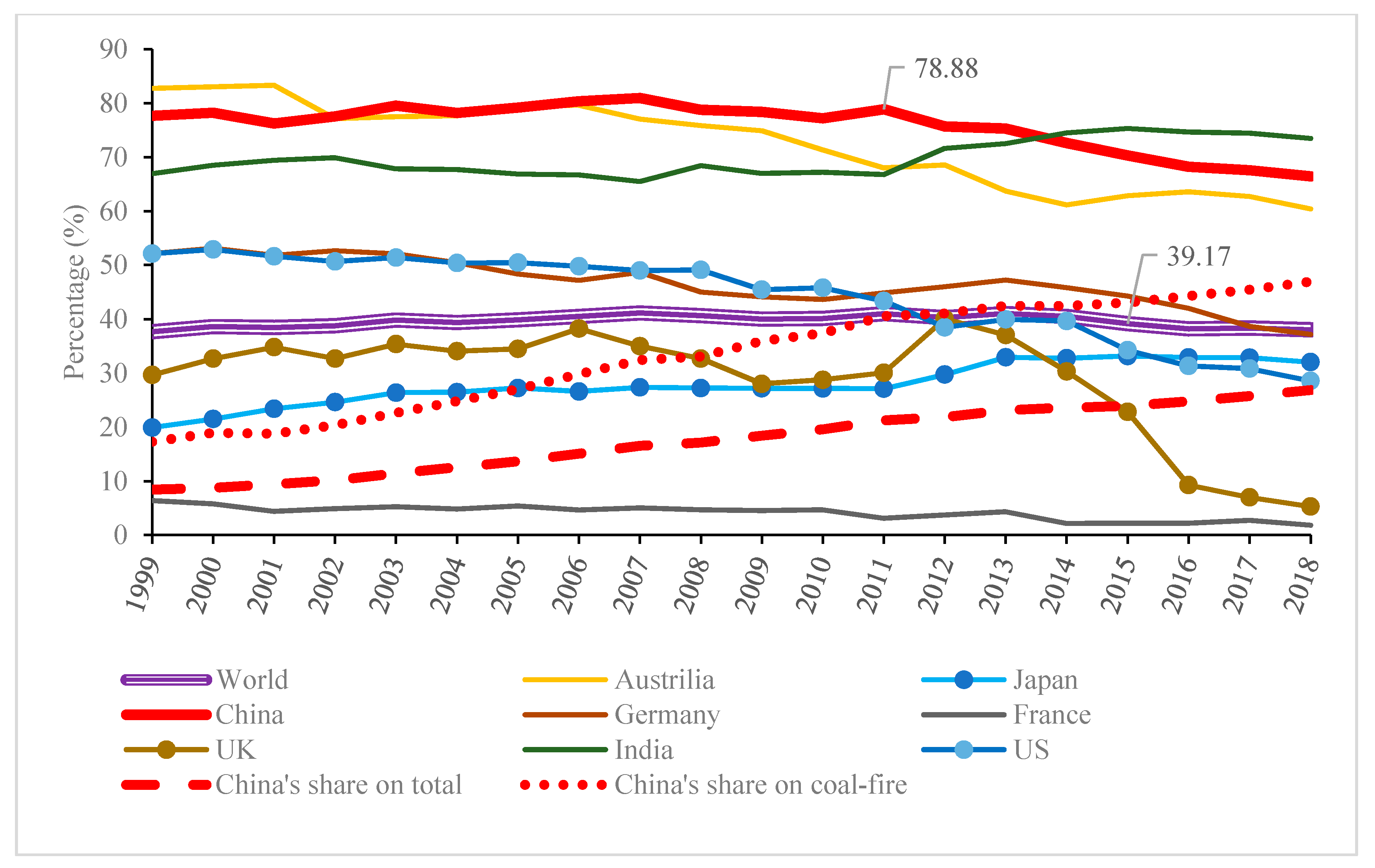
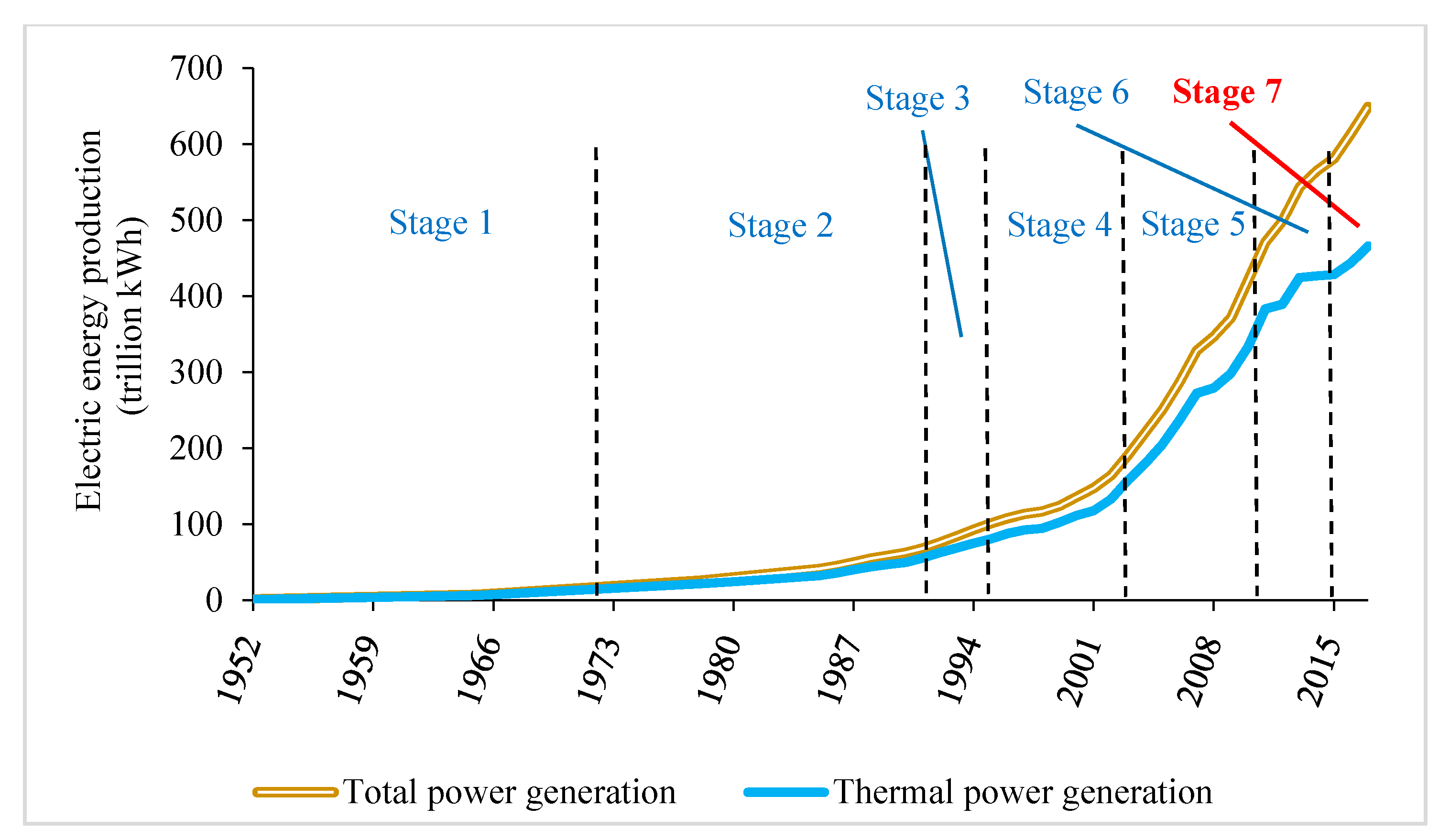
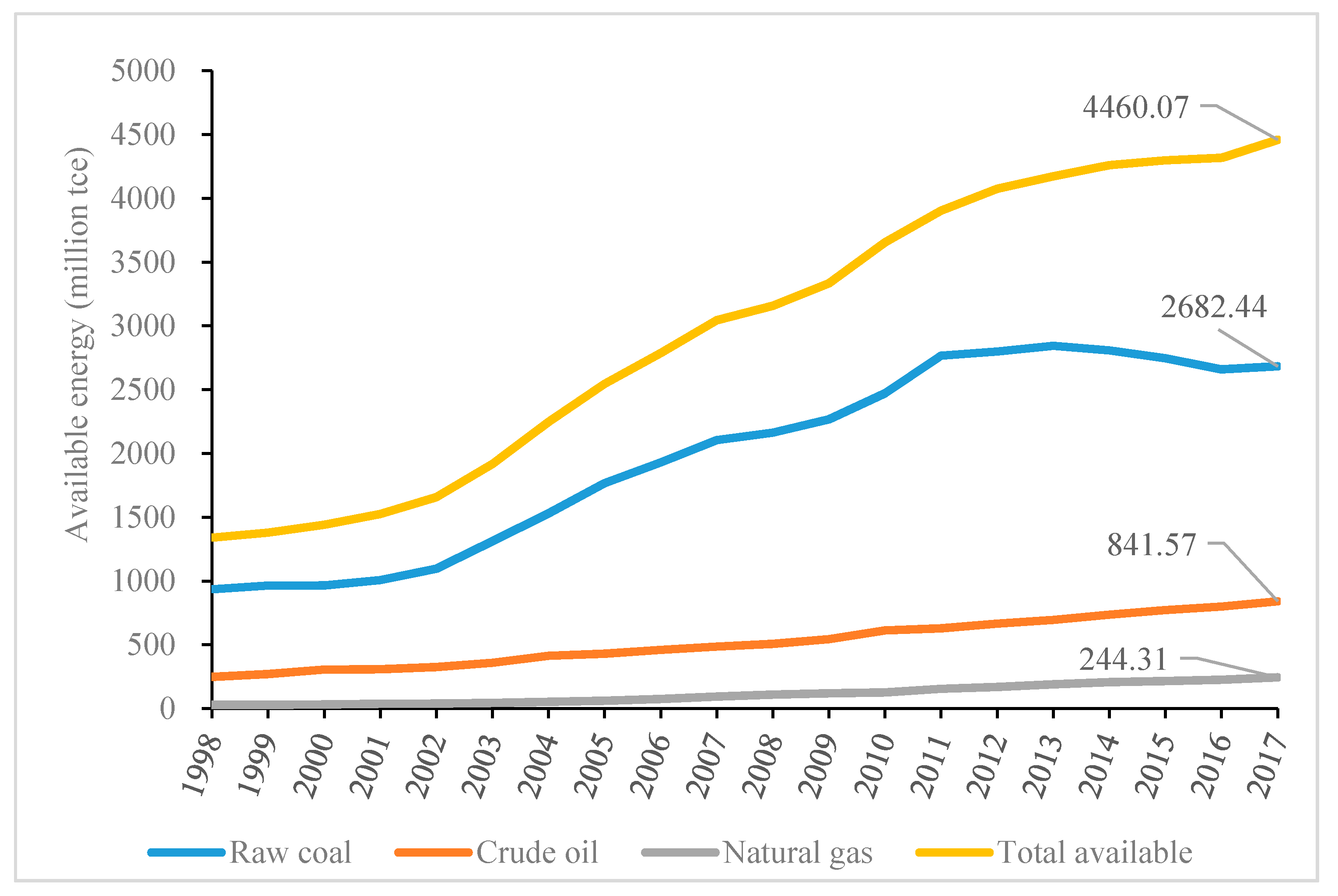
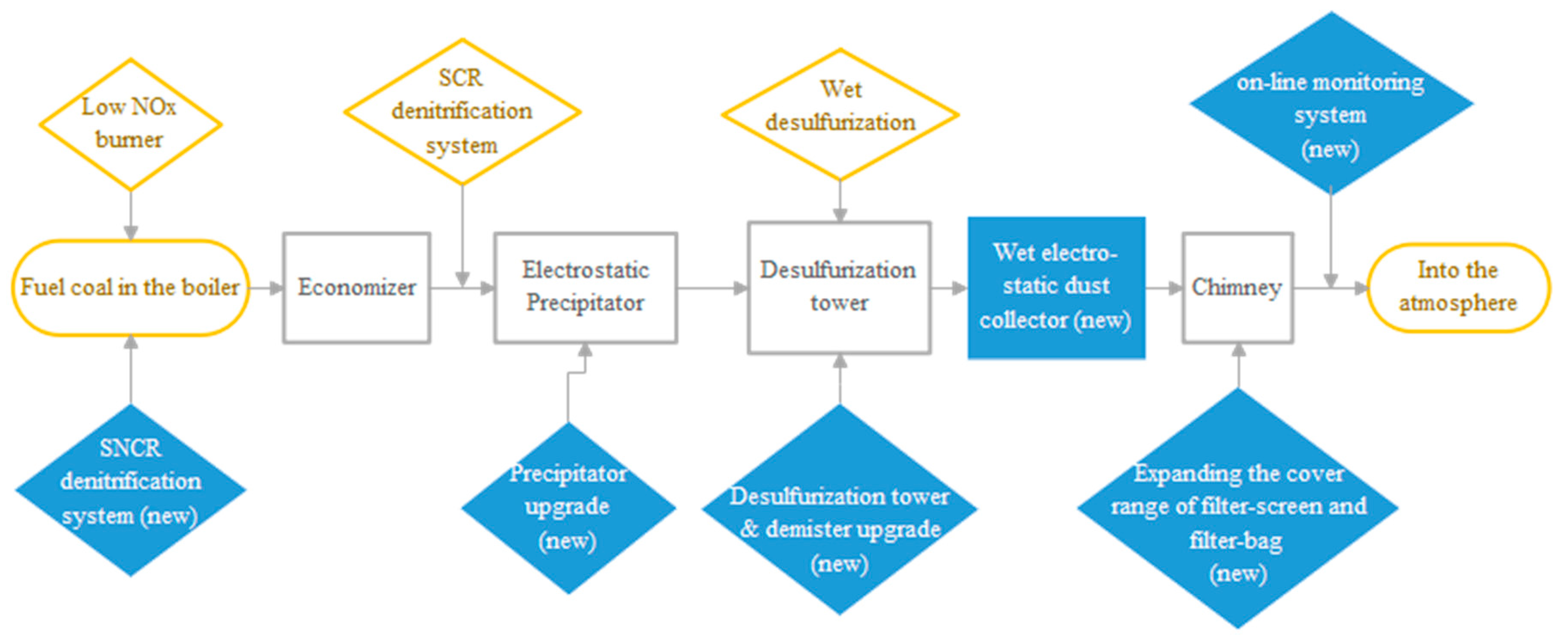
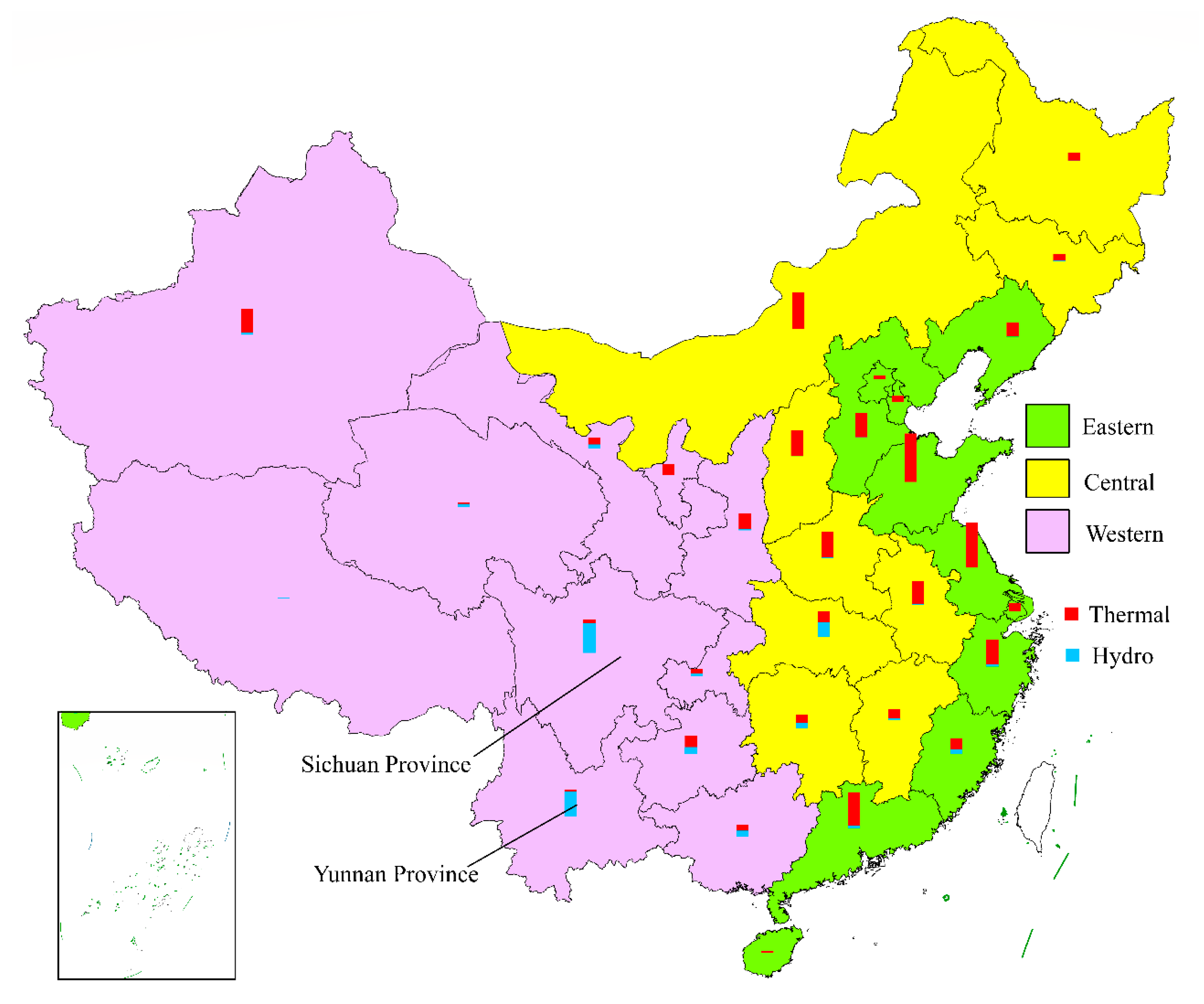
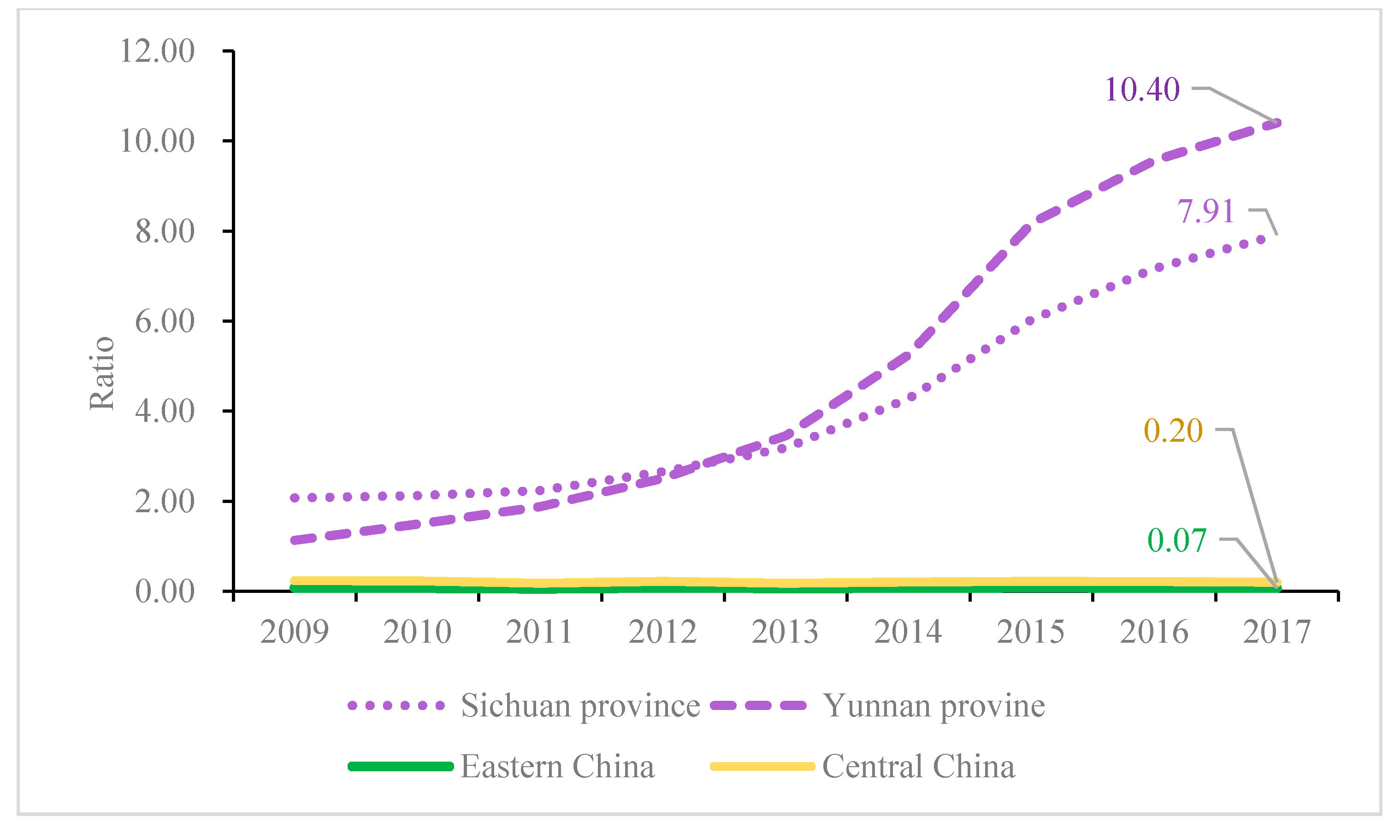

| Emission Standard’s Name | Date of Issue | Concentration Limits (mg/m3) | ||
|---|---|---|---|---|
| SO2 | NOx | Smoke Dust | ||
| Emission standards for air pollutants from coal-fired power plants | Sep 2011 | 100 | 100 | 30 |
| Standards for the discharge of atmospheric pollutants from boilers 1 | May 2014 | 300 (400) | 300 (400) | 50 (80) |
| Energy Development Strategic Action Plan (2014–2020) 2 | June 2014 | No new restricted limits proposed | ||
| Coal-fired energy-saving emission reduction upgrade and transformation action plan (2014–2020) | Sep 2014 | 35 | 50 | 10 |
| Full implementation of the ultra-low emission and energy-saving transformation work plan for coal-fired power plants 2 | Mar 2015 | 35 | 50 | 10 |
| Name of Control Variable (Unit) | Symbol | Generated Pollutant | Taking the Logarithm or Not |
|---|---|---|---|
| Crude steel (million tons) | steel | SO2 | Yes |
| Sulfuric acid (in 100%) (million tons) | sulacid | SO2 | Yes |
| Chemical fertilizer (in NPK 1) (million tons) | fertilizer | NOx | Yes |
| Vehicle holdings (million) | car | NOx and smoke dust | Yes |
| Annual fixed-asset investment (trillion CNY) | fixedasset | Smoke dust | Yes |
| Variable | Region | Obs | Mean | St.d | Min | Median | Max | Unit |
|---|---|---|---|---|---|---|---|---|
| ULE | East | 63 | 1 | 0 | 1 | 1 | 1 | - |
| Central | 70 | 1 | 0 | 1 | 1 | 1 | ||
| West | 14 | 0 | 0 | 0 | 0 | 0 | ||
| Thermal | East | 63 | 220.279 | 129.192 | 58.732 | 225.860 | 514.288 | billion kWh |
| Central | 70 | 147.094 | 95.242 | 51.625 | 89.721 | 375.033 | ||
| West | 14 | 44.850 | 13.520 | 23.804 | 46.072 | 62.810 | ||
| SO2 | East | 63 | 0.668 | 0.471 | 0.019 | 0.593 | 1.827 | million tons |
| Central | 70 | 0.630 | 0.370 | 0.166 | 0.525 | 1.409 | ||
| West | 14 | 0.652 | 0.164 | 0.384 | 0.668 | 0.902 | ||
| NOx | East | 63 | 0.862 | 0.499 | 0.142 | 0.843 | 1.801 | million tons |
| Central | 70 | 0.728 | 0.355 | 0.255 | 0.606 | 1.665 | ||
| West | 14 | 0.330 | 0.071 | 0.224 | 0.340 | 0.429 | ||
| Dust | East | 63 | 0.505 | 0.417 | 0.047 | 0.354 | 1.798 | million tons |
| Central | 70 | 0.523 | 0.282 | 0.188 | 0.447 | 1.507 | ||
| West | 14 | 0.330 | 0.071 | 0.224 | 0.340 | 0.429 | ||
| East | 63 | 2.238 | 2.645 | 0 | 0 | 6.243 | - | |
| Central | 70 | 2.062 | 2.436 | 0 | 0 | 5.927 | ||
| West | 14 | 0 | 0 | 0 | 0 | 0 |
| Explained Variable | Region | DID | Control Variable | Constant | R2 within | Obs. | ||
|---|---|---|---|---|---|---|---|---|
| Eastern | −0.124 *** (−7.23) | No | - | - | −0.455 * (−1.87) | 0.447 | 77 | |
| −0.133 *** (−7.34) | Yes | 0.517 *** (4.79) | 0.321 *** (4.46) | −2.408 * (−6.39) | 0.422 | 77 | ||
| Central | −0.121 *** (−8.84) | No | - | - | −0.388 *** (3.13) | 0.529 | 84 | |
| −0.120 *** (−8.56) | Yes | 0.054 (0.29) | −0.039 (−0.54) | −518 (−0.96) | 0.527 | 84 | ||
| Eastern | −0.140 *** (−7.68) | No | - | - | −5.365 *** (−32.51) | 0.483 | 77 | |
| −0.149 *** (−7.59) | Yes | 0.057 (0.45) | 0.299 *** (3.58) | −5.724 *** (−13.02) | 0.477 | 77 | ||
| Central | −0.148 *** (−8.55) | No | - | - | −4.960 *** (−60.11) | 0.531 | 84 | |
| −0.144 *** (−8.74) | Yes | −0.420 *** (−2.69) | 0.109 ** (1.98) | −3.824 (−8.63) | 0.506 | 84 |
| Explained Variable | Region | DID | Control Variable | Constant | R2 within | Obs. | ||
|---|---|---|---|---|---|---|---|---|
| Eastern | −0.078 *** (−9.37) | No | - | - | −0.273 (−1.50) | 0.587 | 77 | |
| −0.057 *** (−4.29) | Yes | 0.213 *** (3.70) | −0.167 (−1.51) | 0.053 (0.24) | 0.646 | 77 | ||
| Central | −0.093 *** (−10.58) | No | - | - | −0.304 *** (−3.19) | 0.640 | 84 | |
| −0.053 *** (−4.57) | Yes | 0.076 * (1.76) | −0.393 *** (−4.58) | 0.128 (0.94) | 0.758 | 84 | ||
| Eastern | −0.091 *** (−9.94) | No | - | - | −5.188 *** (−52.69) | 0.628 | 77 | |
| −0.065 *** (−5.40) | Yes | 0.168 *** (3.41) | −0.256 ** (−2.59) | −4.717 *** (−24.53) | 0.648 | 77 | ||
| Central | −0.110 *** (−10.04) | No | - | - | −4.893 *** (−69.09) | 0.605 | 84 | |
| −0.098 *** (−6.24) | Yes | −0.021 (−0.43) | −0.144 (−1.30) | −4.700 *** (−31.78) | 0.630 | 84 |
| Explained Variable | Region | DID | Control Variable | Constant | R2 within | Obs. | ||
|---|---|---|---|---|---|---|---|---|
| Eastern | −0.032 *** (−2.61) | No | - | - | −1.014 *** (−3.88) | 0.097 | 77 | |
| −0.036 * (−1.94) | Yes | 0.196 (0.69) | −0.194 (−0.77) | −1.017 *** (−2.90) | 0.092 | 77 | ||
| Central | −0.047 *** (−5.02) | No | - | - | −0.838 *** (−5.78) | 0.174 | 84 | |
| −0.043 *** (−2.93) | Yes | −0.015 (−0.06) | −0.028 (−0.13) | −0.076 *** (−3.60) | 0.178 | 84 | ||
| Eastern | −0.043 *** (−3.33) | No | - | - | −5.932 *** (−28.92) | 0.143 | 77 | |
| −0.052 *** (−2.78) | Yes | 0.064 (0.23) | −0.063 (0.25) | −6.148 *** (−17.68) | 0.154 | 77 | ||
| Central | −0.058 *** (−5.79) | No | - | - | −5.685 *** (−43.30) | 0.210 | 84 | |
| −0.041 *** (−2.66) | Yes | −0.287 (−1.15) | 0.124 (0.54) | −5.458 *** (−25.48) | 0.220 | 84 |
| Explained Variable | Region | DID | Execution Year | Timespan | Control Variable | R2 Within | Obs. |
|---|---|---|---|---|---|---|---|
| East | −0.019 * (−1.71) | 2011 | 2009–2014 | Yes | 0.000 | 66 | |
| Central | −0.015 * (−1.80) | 2011 | 2009–2014 | Yes | 0.113 | 72 | |
| East | −0.007 (−1.10) | 2012 | 2011–2014 | Yes | 0.027 | 44 | |
| Central | 0.001 (0.32) | 2012 | 2011–2014 | Yes | 0.837 | 48 | |
| East | 0.009 (0.58) | 2013 | 2011–2014 | Yes | 0.422 | 44 | |
| Central | 0.014 (0.94) | 2013 | 2011–2014 | Yes | 0.198 | 48 |
Publisher’s Note: MDPI stays neutral with regard to jurisdictional claims in published maps and institutional affiliations. |
© 2020 by the authors. Licensee MDPI, Basel, Switzerland. This article is an open access article distributed under the terms and conditions of the Creative Commons Attribution (CC BY) license (http://creativecommons.org/licenses/by/4.0/).
Share and Cite
Ye, P.; Xia, S.; Xiong, Y.; Liu, C.; Li, F.; Liang, J.; Zhang, H. Did an Ultra-Low Emissions Policy on Coal-Fueled Thermal Power Reduce the Harmful Emissions? Evidence from Three Typical Air Pollutants Abatement in China. Int. J. Environ. Res. Public Health 2020, 17, 8555. https://doi.org/10.3390/ijerph17228555
Ye P, Xia S, Xiong Y, Liu C, Li F, Liang J, Zhang H. Did an Ultra-Low Emissions Policy on Coal-Fueled Thermal Power Reduce the Harmful Emissions? Evidence from Three Typical Air Pollutants Abatement in China. International Journal of Environmental Research and Public Health. 2020; 17(22):8555. https://doi.org/10.3390/ijerph17228555
Chicago/Turabian StyleYe, Penghao, Senmao Xia, Yu Xiong, Chaoyang Liu, Fei Li, Jiamin Liang, and Huarong Zhang. 2020. "Did an Ultra-Low Emissions Policy on Coal-Fueled Thermal Power Reduce the Harmful Emissions? Evidence from Three Typical Air Pollutants Abatement in China" International Journal of Environmental Research and Public Health 17, no. 22: 8555. https://doi.org/10.3390/ijerph17228555






